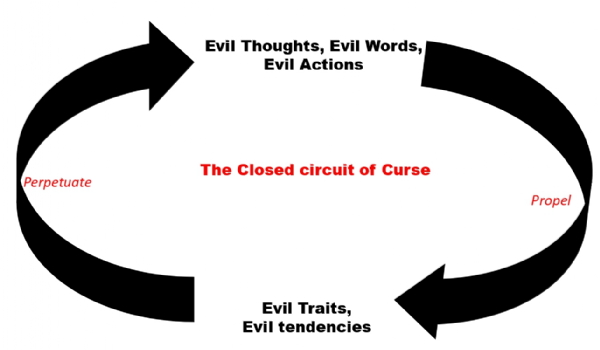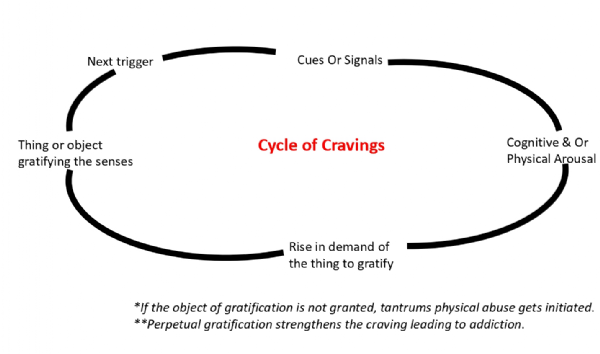Lessons from the East XVI: Unfolding the concept of Craving & Addiction - The Solution & the fix - Part 2
16 Nov 2022 11:51:34
Can One's environment lead to one getting into a form of addiction?
Rethink Rehabilitation as a solution! Can finding a compelling reason to forego addiction be fruitful?
The Recap
In the first part Creation of Craving & Addiction, (click here to read Part I) we encountered three situations of a drug overdose, abetment to suicide, and loss of job, reputation, and credibility on account of bad behavior.

These were the outcomes, but what caused these outcomes, will be assessed in this part. Also, could these outcomes be preempted or anticipated, and if yes, how could they be prevented?
What seemed to be the story of Mandeep, Rashmi, or Anthony is our or ours' story.
Shifting gears here.
Is there a Single Theme running across the stories?
One may be thinking that the three stories of part 1 are three different stories with three different contexts in three different settings, and thus how can there be a commonality between all three?
There is commonality and there is a single theme that runs through all the stories. What started as a harmless trial or usage on the persuasion of friends, or infatuation with looks, or subtle desire to receive praise on all acts turned into a craving after some point in time. Thus the concept of Cravings is common all across.
In the first story, the coolness of the act and its repetition turned into cravings, and the same eventually perpetuated into devilish addiction to drugs. The second story started with a craving for the physical body or, in simpler terms, a craving for looks, which turned into the reason that contributed to the death. The third story started with being popular, pursuing external praise, and focusing on what the world wanted one to do and be, and that led to one’s downfall.
Concept of Cravings
But what are these cravings and how do they get formulated in oneself?
Craving is essentially an emotion that is generated after exposure to cues. Cues or signals lead to arousal and arousal subsequently turns into demand and perpetual fulfillment of the demand leads to addiction.
The cues ignite the emotion in parallel creating cognitive as well as physical arousal and thus overtaking the mind and the body of the person both.
These cues can be looks, an attractive body for pro-creation, or it can be social gratification, or social acceptance.
These cravings emerge on account of traits and tendencies one gathers or is exposed to. These traits and tendencies get firmed up due to repetition in one's thoughts, one’s conduct, one’s behavior, and one’s actions.
There is a circular link between deeds and traits and tendencies. As stated above one’s thoughts and one’s conduct leads to one’s craving and these craving eventually determine the actions of a person.

Another aspect is that cravings are not only bad. There can be good cravings that induce one to have good, constructive, spiritual thoughts, and those thoughts enable one to pursue positive actions.
Thus good or bad both thoughts and actions are the results of these cravings.Physical Attraction
What happened to Rashmi was a result of a physical attraction, but most under the influence of cravings forget, that one’s body is different from one’s thoughts, behavior, and one’s soul. The one who only focuses on external beauty and gets infatuated by it realizes that either one has made a mistake as the beautiful body may not have a beautiful mind and heart inside or realizes that beyond a beautiful body what is worth cherishing is a beautiful mind and heart.
Social Approval
Another evil in society is the need of being approved. Social acceptance, social gratification, being popular, and being noticed by others whether physically or virtually is an ill that expands fast. The one who falls for it always remains a victim, driven by the emotions of others, never realizing one's true self.
After a point in time, pretension and real self gives rise to conflicting emotions and constant jugglery between one versus another, makes oneself or one's mind forget which one is true. A common example of it is teenagers pretending to be warm, hospitable, and well-mannered, outside with friends in a social environment whilst being rude, hostile, and ill-mannered behind closed doors.
These emotions, the feeling of being used and the dirt of cleaning the dirty laundry, and the corrupted baggage of others remain suppressed in the deep subconscious and once one gets an opportunity to express one’s true self, that is a composite of the hidden pain, the hideous opinion about others, the hateful agreements with others at the terms dictated by others, and till now graciously accepted by oneself or in a nutshell, the silent growing devil sitting, inside comes out unknowingly as it happened in case of Anthony.
These inner contradictions occur when one loses sight of the fact that perpetual happiness lies neither in forcing oneself to be in line with what others are thinking nor in succumbing to the satiation of one’s senses.
Real happiness or happiness in perpetuity can only be realized when one knows the truth that one is merely a part of the Brahm (Param-atma, the almighty, the divine) and witnessing that within oneself in the form of Jiva-Atma (a part of Param –Atma) brings real happiness and that too in perpetuity. This is the state when one becomes Trigunateet (one who is above all three forms of manifested energies of Sattva, Rajas, and Tamas). From a practical perspective, the ones who pursue the path of Dharma whether earning money or fulfilling desires remain always in peace and happy.
This is also the route to achieve Moksha (salvation), the last step of Purushartha, the very reason why humans take life form.
Tracking back to the core question of Cravings and Addiction.
Everyone has good and bad cravings. Bad cravings lead to one’s imprisonment, in other words, these desires entangle the person and in an illusive manner, force the person to be its servant or victim. These cravings lead to a destructive and eventually criminal mentality. These are also known as Asuri or demonic properties of a human being.
On the other hand, Good cravings enable one to be free from bondage and help a person to self-realization. This is also known as Divine or Devaik Properties.
Reference to it is given in Shreemad Bhagwad Geeta as well.
Chapter 16, Verse 1 to 3 - Shreemad Bhagawad Geeta
श्रीभगवानुवाच |
अभयं सत्त्वसंशुद्धिर्ज्ञानयोगव्यवस्थिति: |
दानं दमश्च यज्ञश्च स्वाध्यायस्तप आर्जवम् || 1||
अहिंसा सत्यमक्रोधस्त्याग: शान्तिरपैशुनम् |
दया भूतेष्वलोलुप्त्वं मार्दवं ह्रीरचापलम् || 2||
तेज: क्षमा धृति: शौचमद्रोहोनातिमानिता |
भवन्ति सम्पदं दैवीमभिजातस्य भारत || 3||
Meaning: Lord Krishna says: O scion of Bharat, these are the saintly virtues of those endowed with a divine nature—fearlessness, purity of mind, steadfastness in spiritual knowledge, charity, control of the senses, sacrifice, study of the sacred books, austerity, and straightforwardness; non-violence, truthfulness, absence of anger, renunciation, peacefulness, restraint from fault-finding, compassion toward all living beings, absence of covetousness, gentleness, modesty, and lack of fickleness; vigor, forgiveness, fortitude, cleanliness, bearing enmity toward none, and absence of vanity.
Chapter 16, Verse 10 Shreemad Bhagawad Geeta
काममाश्रित्य दुष्पूरं दम्भमानमदान्विता: |
मोहाद्गृहीत्वासद्ग्राहान्प्रवर्तन्तेऽशुचिव्रता: || 10||
Meaning: Harboring insatiable lust, full of hypocrisy, pride, and arrogance, the demoniac cling to their false tenets. Thus illusioned, they are attracted to the impermanent and work with impure resolve.
(To understand Diavik and Asuri Sampada, read the complete chapter 16 of Shreemad Bhagwad Geeta)
Moving ahead
How can one get rid of ill cravings that subsequently turn into addiction?
1. Cues - The first step is to know the thoughts or the cues that trigger these cravings.
2. Deciphering what one is craving - The next step is to get an understanding of what one's self is craving.
3. Recognition & Acceptance - Acknowledging that things or cravings exist in oneself and acceptance is the next step that also leads to a cure.
4. Self-Analysis - The next step to a cure is Self-analysis and writing it down on a piece of paper or in a diary. Self-Analysis comprises finding the way these cravings emerge and how these can or are taking a bigger form. As urges thrive, cravings in due course of time turn into an addiction. Self-analysis helps to pinpoint the problem.
5. Inner Conversation - When one realizes that by succumbing to the cravings, one is not satiating them but propelling them to be even bigger, one needs to start having a conversation with inner self and this inner discussion leads to a pause rather giving a boost to it.
6. Shunning the stimuli, in the august company of people & books - Staying away from people or environments who are involved in similar cravings or addiction and reading about the wisdom of life and books that can change the current way of thinking or being in the company of spiritual humans surely is the most successful way of cutting the cravings.
Everything created is adaptable to the habitat it lives in. Change the habitat, the habits will change.
Enablers to remove cravings & Addiction
Asking the question that
1. If these cravings give happiness, then why is it momentarily?
2. Once one reaches the target or enjoys the object of pleasure, why does one run after the same one again or the next one?
3. Why is this pleasure not long-lasting even though the object one desired to achieve remains within one’s control?
Focusing on these questions brings rationality to humans.
The interesting thing is these cravings can come to anyone, irrespective of age, experience, position, stature, knowledge, situation, etc.
The question here is to ask why even wise, educated, knowledgeable people become victims of it.
The answer lies in Anartha Parampara, the vicious cycle of Craving and Addiction (Adopted from Vedant)
The cycle of ignorance is Anartha Parampara. The cues or triggers for cravings generally start from Worries – small or big, insignificant or insignificant, material or immaterial.
These worries lead to triggers. Triggers can emerge from the environment, that one is exposed to like media, and promotional material, or it can be people one is exposed to - Social gatherings, office environment, friend circle, etc.
These triggers lead to taking certain actions to satiate the craving. As soon as the action or act is over, the craving starts again. The mental memory knows the path of satiating the craving last time and it drives the person to take action again. The action this time can be bigger. If there are no resources or no methods to take action, tantrums or counteractions start.

Socially acceptable & not acceptable Cravings
The person doesn’t even realize when one has become a prisoner of these cravings. The cravings are not only restrained to the ones that are supposedly socially ostracized like drugs, substance abuse, or porn.
Cravings include the ones that are harmful to oneself that may or may not be criticized by society like constant need for sex, sugary items, screen, junk food, smoking, drinking, need to be accepted in the group, strong yearning for being famous, being socially acknowledged for every action or performance, hijacking every conversation and discussion, acceding to one’s proclivity that one’s presence always is recognized, making others act in a manner that one remains the center of attention, etc.
When Craving grows, various kinds of thoughts emerge. These thoughts are accompanied by greed to satiate those cravings, anger also follows if there is a delay or denial of gratification and more desires tag along that is related to the initial craving or desire of repeated gratification.
As these thoughts expand, worries expand too. Expansion in worries coerces that expansion of actions. Further expansion of action leads to further worries in the same proportion. With further worries, further expansion of cravings takes place in the same proportion.
Example
When one faces an adverse outcome from a situation be that separation, rejection, denial, loss, etc one gets worried, and this worry leads to the innate need for liquor in the causal body. This innate need brings the thought of liquor drinking in the mind. This thought then prompts the physical body to take action and drink liquor.
The person once drinks liquor, and finishes it, the craving for drinking the liquor again increases in the same proportion.
When one’s craving for liquor increases then the worry of drinking also again increases. This further increases the cravings and thus the person unknowingly makes one’s cravings even firmer.
This then leads to addiction.
Some believe that shifting the addiction from a more harmful to a less harmful substance can help. But that’s only transitory. The shifting of the substance for example from liquor to sugary edibles is not the solution. This is temporary. When the bigger pressure or worry comes again, the person moves back to the original craving or addiction.
The only way to change is through Self-control, along with the change in environment and change in the company of people. These things help in controlling the thought that creates triggers and thus ensures the cravings are stopped. Understanding that worries are not the solution but only aggravates the problem since the outcome is not in one’s hand, reaffirming this belief, again and again, helps in reducing the triggers further. Also, this form of Self Conversation helps the Causal body to decimate the root of cravings where it starts from.
Can this entire process make a person believe that one’s feelings are being oppressed or suppressed instead of being cured?
As mentioned above and reiterating that the person needs to have a conversation and logical arguments with oneself on the origin, trigger, worries, and actions that lead to addiction.
The most compelling amongst them are the sound reasons that only a person can find why one must stop these cravings as not only does the person suffers in the process of cravings and addiction but one’s near and dear ones too get engulfed in the viciousness and repercussion of the outcome.
Thus Siddhartha Rastogi says, Philosophy of controlling what is controllable and letting go of what is un-controllable, giving up on short-term gratification for long-term goodness, and focusing on the input and setting up a schedule & process will cut the chances of cravings, addiction, and the circular path of Ananrth Parampara.